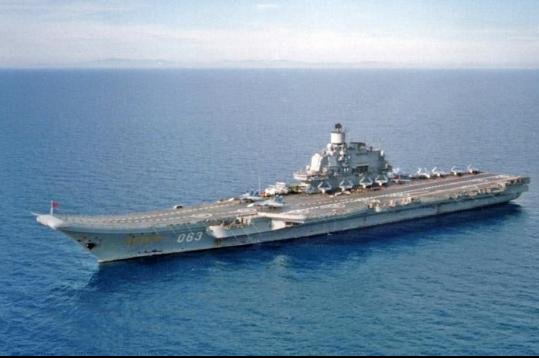The centerpiece of Russian naval operations in Syria was the deployment from its Northern Fleet of the country's sole aircraft carrier, the Admiral Flota Sovetskogo Soyuza Kuznetsov, in its first combat mission. File Photo courtesy of U.S. Department of Defense
March 6 (UPI) -- Russian military intervention in the Syrian conflict began in September 2015. Six months later, Russian President Vladimir Putin stated that the military operations there cost the country's Defense Ministry $483 million.
For Western observers, the most striking element of Russia's Syrian intervention was the deployment of a significant portion of Russia's naval assets there, its largest surface deployment since the Cold War. At a ceremony in the Northern Fleet's Severomorsk base honoring the return of the Russian sailors, Putin stated it was his idea to send Russian naval units to Syria.
The centerpiece of Russian naval operations was the deployment from its Northern Fleet of the country's sole aircraft carrier, the Admiral Flota Sovetskogo Soyuza Kuznetsov, in its first combat mission.
The Kuznetsov was joined by other Russian warships, including nuclear-powered battle cruiser Petr Velikii, the Severomorsk and the Vice Admiral Kulakov destroyers, support vessels and anti-submarine ships.
During the Syria campaign, a new generation of Russian Kalibr cruise missiles debuted, launched from corvettes, frigates and diesel-electric submarines. During the two months of the Kuznetsov's battle operations, the Russian Defense Ministry reported that its naval aircraft flew 420 combat missions, 117 of them at night, striking 1,252 targets, including infrastructure, concentrations of fighters and military equipment.
Russian analysts reported that the carrier's deployment and combat operations cost about $170 million — less than the cost of two new F-35 fifth-generation U.S. fighter aircraft.
Despite the relatively modest cost of the Russian intervention, it has paid off handsomely for its military. Moscow and Damascus have signed a 49-year lease allowing the Russian Navy to use the Syrian port of Tartus, which will be upgraded to handle up to 11 warships at once, giving the Russian Navy a permanent base in the eastern Mediterranean.
In the future, warships primarily from Russia's Black Sea Fleet will deploy there to support what the Russian Defense Ministry is calling the Russian Navy's "permanent" group in the Mediterranean. This development should surprise no one, as rebuilding Russia's military presence in the Mediterranean was one of the goals outlined in the 2015 edition of Russia's maritime doctrine.
Above and beyond the value of the new naval base, however, is Russia's long-standing concern that the chaos in Syria was providing a training ground for jihadists. The Russian General Staff and the Federal Security Service said there are as many as 4,000 militants from Russia and about 5,000 from former Soviet republics fighting in Syria.
The Russian government is concerned that these battle-hardened jihadists could return home having acquired lethal skills. Reinforcing this concern, at his meeting with the sailors, Putin said Russia does not intend to interfere in Syria's internal affairs but wants to deal with the terrorists and that Russia's goal in Syria is to stabilize the legitimate government and to "put an end to the terrorist blight."
The net result of Russia's military support for Syrian President Bashar al-Assad's regime is a guarantee that Russia has a place at the table in peace discussions along a return as a major diplomatic player in the Middle East.
However, if Russian military valor is helping to turn the tide in Syria, its presence there after the end of major military operations is much less clear. Analyses estimate that the Syrian economy will need more than $1 trillion to recover from the civil war. The billions of dollars needed to reconstruct Syria are far beyond Moscow's means, which will likely focus instead on narrowly defined projects with economic value, such as rebuilding the country's oil and hydrocarbons infrastructure.
In neighboring Iraq, where Western military power predominated, Russian companies were excluded from such projects, a situation that the Russian government is certain to ensure will not recur in Syria.
Such concerns are far in the future. For the moment, Russia has secured the use of an invaluable naval base, ending NATO's dominance of the Eastern Mediterranean. Moscow has deployed a pragmatic policy of supporting what it defines as "legitimate" governments, combined with a stout anti-terrorist policy unaffected by notions of regime change for human rights lectures, policies that ensure it a sympathetic hearing in a number of Middle Eastern countries.
Not a bad return on a military investment of less than $1 billion.
This article originally appeared at The Arab Weekly.















